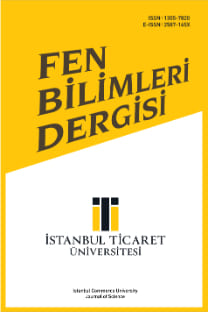DİSİPLİNLERARASI BAĞLAMLARDA ARAŞTIRMA PERFORMANSI SİMÜLASYONLARI: BİR MODEL VE BİR UYGULAMA
Bu makalenin amacı, çapraz etkileşimlerin karakterize ettiği disiplinlerarası bağlamlarda, arz ve talebe dayalı bir araştırma performansı modeli kurmak ve performansın seyrini simüle etmektir. Makalede, beşeri sermaye, araştırma teknolojisi ve disiplinlerarası etkileşimlerin dikkate alındığı bir model aracılığıyla, muhtemel performans yörüngeleri incelenmektedir. Beşeri sermayenin düzeyi ve teknolojiye bağlı olarak farklı yörüngelerin mümkün olabileceği ortaya konulmaktadır. Üniversite yönetimleri, değişik performans yörüngeleri arasında, hedeflerine uygun seçimi, araştırmaya öncelikler doğrultusunda tahsis edilmiş kaynakları kullanarak, yapabilirler.
Anahtar Kelimeler:
Araştırma performansı simülasyonları, alanlar-arası çapraz etkiler, teknoloji
SIMULATIONS OF RESEARCH PERFORMANCE IN CROSS-DISCIPLINARY CONTEXTS: A MODEL AND AN APPLICATION
The purpose of this paper is to construct a model of research performance, based on a demand-and-supply set-up, in a cross-disciplinary context and simulate the trajectory of research performances. We take into account the effects of human capital and research technology as well as interactions among different disciplines/subjects so as to theorize about possible shapes of these trajectories. It turns out that, depending on the levels of human capital and technology, research performances could have different trajectories over time. Contingent upon the priority-driven amount of resources devoted to research, university administrators could choose a path among different trajectories, a path that is most compatible with their institutional objectives.
___
- Abdullah, L., Jaafar, S., Taib, I., (2013), Ranking of Human Capital Indicators using Analytic Hierarchy Process, Procedia-Social and Behavioral Sciences 107, 22-28.
- Abramo, G., Cicero, T., D'Angelo, C.A., (2012), Revisiting size effects in higher education research productivity, . Higher Education,3 (6), 701-717.
- Abramo, G., D'Angelo, C.A., Di Costa, F., (2014), Investigating returns to scope of research fields in universities. Higher Education 68 (1), 69-85.
- Adams, J.D., Clemmons, J.R., (2011), The role of search in university productivity: Inside, outside, and interdisciplinary dimensions. Industrial and Corporate Change, 20 (1), 215-251.
- Barlas, Y., Diker V., (2000),. A Dynamic Simulation Game for Strategic University Management, Simulation and Gaming, 31(3), 331-358.
- Barlas, Y. , Diker, V. & Polat, S. (eds.), (1997), Systems Approach to Learning and Education into the 21st Century (Proceedings of 15th International System Dynamics Conference. Istanbul: Boğaziçi University Press.
- Dundar, H., Lewis, D.R., (1995), Departmental productivity in American universities: Economies of scale and scope. Economics of Education Review 14 (2), 119-144.
- Fedderke, J. W., Luiz, J. M., (2008), Does Human Capital Generate Social and Institutional Capital? Exploring Evidence from South African Time Series Data, Oxford EconomicPapers, 60 (4), 649-682.
- Grayson, J. P., (2004), Social Dynamics, University Experiences, and Graduates' Job Outcomes, British Journal of Sociology of Education, 25 (5), 609-627.
- Ivanov, V. V., Markusova, V.A., Mindeli, L. E., (2016), Government investments and the publishing activity of higher educational institutions: Bibliometric analysis, Herald of the Russian Academy of Sciences 86 4, 314-321.
- Jaffe, A.B., (1989), Real Effects of Academic Research, The American Economic Review, 79 (5), 957-970.
- Kara, A., (2011), Modeling social processes, Istanbul Commerce University, Mimeo.
- Kara, A., (2013a), Dynamics of Performance and Technology in Higher Education: An Applied Stochastic Model and a Case Study. Hacettepe Journal of Mathematics and Statistics 42 (1), 87-99.
- Kara, A., (2013b), Educational Technology and Human Capital,” Procedia – Social and Behavioral Sciences, 106, 970–979.
- Kara, A., (2014), A System Dynamics-Based Decision Support Model for Universities. Istanbul Commerce University, Mimeo.
- Kara, A., (2016), "Simulations of information technology-induced teaching performance in cross-disciplinary settings: a model and an application", The International Conference on Intercultural Education, Education, Health And Ict: From A Transcultural Perspective, Almeria, Spain, June 2016.
- Kodama, H., Watatani, K., Sengoku, S., (2013), Competency-based assessment of academic interdisciplinary research and implication to university management. Research Evaluation, 22 (2), 93-104.
- Miller, K., Moffett, S., McAdam, R., Brennan, M., (2013), Intellectual capital: A valuable resource for university technology commercialisation?. Proceedings of the European Conference on Knowledge Management, ECKM, Volume1, 429-437.
- Munoz, D.A., (2016), Assessing the research efficiency of higher education institutions in Chile: A data envelopment analysis approach, International Journal of Educational Management 30 ( 6), 809-825.
- Neri, F., Rodgers, J.R., (2013), Eagles and Turkeys: Human Capital Externalities, Departmental Co-authorship and Research Productivity. Australian Economic Papers 52 (3-4), 171-189.
- OECD, (2001), The Well-Being of Nations: The Role of Human and Social Capital. OECD, Paris.
- Pastor, J.M., Serrano, L., (2016), The determinants of the research output of universities: specialization, quality and inefficiencies, Scientometrics 109 (2), 1255-1281.
- Singell, L.D., Tang, H-H., (2013), Pomp and circumstance: University presidents and the role of human capital in determining who leads U.S. research institutions, Economics of Education Review, 32, 219–233.
- Spencer, J. W., (2001), How Relevant Is University-Based Scientific Research to Private High-Technology Firms? A United States-Japan Comparison, The Academy of Management Journal, 44 (2), 432-440.
- Walton, A. L., Tornatzky, L. G. & Eveland, J. D., (1986), Research Management at the University Department, Science &Technology Studies, 4 (3/4), 35-38.
- ISSN: 1305-7820
- Yayın Aralığı: Yılda 2 Sayı
- Başlangıç: 2002
- Yayıncı: Doç. Dr. Necip Şimşek
Sayıdaki Diğer Makaleler
The new algorithm involving Minimum Spanning Tree for computer networks in a growing company
ÇEVRESEL ETKİLERİN EKONOMİK MALİYETİ
GİRİŞ KALİTE KONTROL SÜREÇLERİNDE DEĞİŞKENLERE YÖNELİK BİR KABUL ÖRNEKLEMESİ SİSTEMATİĞİ
Emre ÇEVİKCAN, Sevcan YILDIRIM ÖZER
DİSİPLİNLERARASI BAĞLAMLARDA ARAŞTIRMA PERFORMANSI SİMÜLASYONLARI: BİR MODEL VE BİR UYGULAMA
